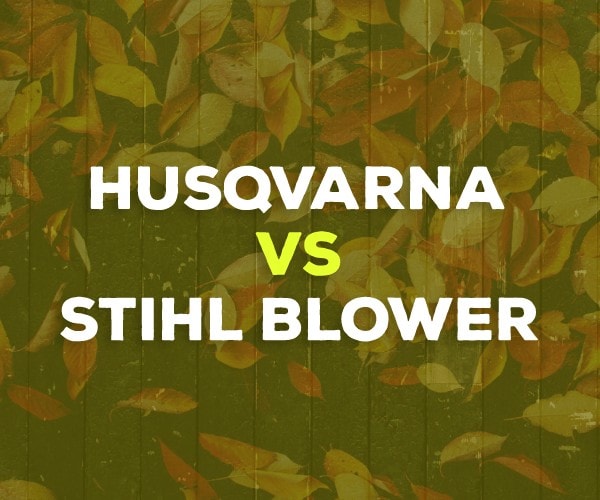
There’s nothing more frustrating than having to use a rake to clear away large piles of leaves and debris. It not only takes a long time to do, but it can also really hurt your back. The powered blower is one of the most underrated tools in the market. Husqvarna vs. Stihl Blowers offer two of the best brands available.
That’s why automatic and gas leaf blowers are one of the greatest garden inventions and something we recommend every household have. They can be used in a wide variety of situations—from blowing leaves to clearing snow—and they make life a lot easier.
There are lots of different kinds of automatic and gas leaf blowers out there with all sorts of different power levels, but two of the most popular brands are Husqvarna and Stihl
In this article, we’ll look at two of their most popular blowers to see how they stack up.
Husqvarna vs. Stihl: Brief Company Histories
If you like tools at all, it’s likely that you’ve heard of Husqvarna and Stihl. These two European companies are worldwide giants in tool manufacturing and for good reason. They both have a reputation for extreme durability, comfort, and ease of use, and have devoted fans across the world.
Husqvarna is a Swedish company that was originally founded in 1689. It began as a weapons manufacturing company but changed over time with the culture of Sweden. Since 1689, it created a lot of different products—from sewing machines to motorcycles—but its primary focus for the last 100 years has been power tools.
Today, Husqvarna is the largest producer of outdoor power products in the world. It owns several smaller brands, including Poulan Pro and you can find one of its tools in over 100 countries around the world.
Stihl is a German company that was founded in 1926, a full 237 years after Husqvarna. However, in its 92 years of operation, it has developed a serious reputation for hard-working power tools that will last a long time. It is still a privately-owned company to this day, a rare occurrence among these large global entities and you can find Stihl products in 90 countries around the world.
Though Stihl is a German company, it has a major headquarters in Virginia Beach, Virginia. The company employs over 2,100 people in the United States—1,900 in Virginia Beach alone—and many of the tools that are sold in the U.S. are actually made in this facility.
The Stihl and the Husqvarna blowers that we review in this article are both heavy-duty gas machines. Both are built in a “backpack” style and are designed to move some serious debris.
They’re great for moving snow or leaves, but might not be as helpful if you are trying to clear out a gutter or hard-to-reach area.
Stihl BR 600
The Stihl BR 600 is a cordless, backpack blower that is guaranteed to get the job done well. It’s a little lighter in power than the Husqvarna, but it is also physically 3 pounds lighter as well. Stihl is an extremely well-respected brand, and their blowers are manufactured here in the United States.
Husqvarna 580 BTS
The Husqvarna blower comes from one of the most trusted brands in the world. It uses several pieces of proprietary technology to make the blowing experience more powerful and comfortable than other blowers on the market. It is a fuel efficient tool that will help clean out your driveway in no time.
Head to Head
Though these two machines perform the same ultimate function, there are a few key differences between the two. There are a few things you should consider when buying a blower, but we’ve compared three major areas: power, comfort and safety, and ease of use and perks.
Power
Power is measured in a couple of different ways in blowers, including the engine capacity, the amount of air that is blown through the funnel, and the speed at which the air blows.
The Husqvarna and the Stihl don’t differ very much when it comes to engine power, both using roughly 4 horsepower to get the job done.
However, even though it’s not directly related to power, the Husqvarna X-Torq® engine is worth noting because of its ability to reduce exhaust emissions by as much as 60% compared to other engines.
The X-Torq® also helps make the entire system more fuel-efficient, so there are fewer stops to refill the tank, leading to a more productive machine overall.
When it comes to air power, the Husqvarna also does better overall. It has a 1024 cubic-feet-per-minute rating (the measure of the volume of air the blower moves, also known as CFM) in its housing and 908 CFM in the pipe.
Conversely, the Stihl blower only has a CFM rating of 677 at the nozzle, a number that’s significantly lower.
The Husqvarna also has a better average speed of 209 miles per hour with a flat nozzle and 206 with a round one.
The Stihl’s average air velocity is 199 miles per hour, though it can go as high as 238 if needed.
Comfort and Extra Perks
One of the reasons you buy a backpack blower is to be more comfortable clearing debris. However, just because the backpack blower is inherently easier to clear debris with, doesn’t mean that it is automatically a comfortable machine.
The design has a major impact on comfort levels and overall safety, and both companies do fairly well in this arena.
The Husqvarna and the Stihl both have adjustable support harnesses that are designed to breathe and move.
More importantly, though, they distribute the weight of the system evenly across the shoulders so that the machine is easier to carry overall.
Since both of these are over 20 pounds and intended for long periods of use, this makes a difference.
There are also several perks that each of these machines offers to make the experience easier.
One is the “cruise control” feature that the Husqvarna provides that allows you to set the blowing speed so that it’s easier to handle.
This is nice for if you are going to be blowing over a long period of time and don’t want to feel sore afterward.
Another perk to consider is environmental friendliness. Since power tools are constantly running and use gasoline, it’s important to consider the impact these machines have on the environment.
Both the Husqvarna and the Stihl are low-emissions producing, something that’s helpful for the planet but also for user health.
Safety
Safety is always something to consider when using a power tool, regardless of whether it is a saw or a blower. With blowers, the primary concerns are vibration and noise.
Vibration is impossible to get rid of, but it can have serious negative consequences for health.
That’s why most companies, including Stihl and Husqvarna, install vibration dampeners in their tools.
Husqvarna’s proprietary LowVib® dampeners result in a 1.6 m/s² vibration at the handle, a level that’s comfortable to use and which helps reduce fatigue.
These dampeners also help reduce noise caused by machines, another serious health hazard.
Husqvarna has a guaranteed sound power rating of 112 decibels and a sound pressure rating of 100 decibels. Stihl on the other hand only provides its sound pressure rating, which is 75 decibels.
Sounds above 85 dB are harmful, and any sustained noise for a long time can create feelings of fatigued. So, regardless of whichever tool you choose, we recommend you use earmuffs or earplugs while blowing.
Final Thoughts
Both the Stihl and the Husqvarna are great options and they have devoted fans worldwide who wouldn’t dream of using another tool.
Based on what we have covered, we would say that either blower would be a great purchase.

